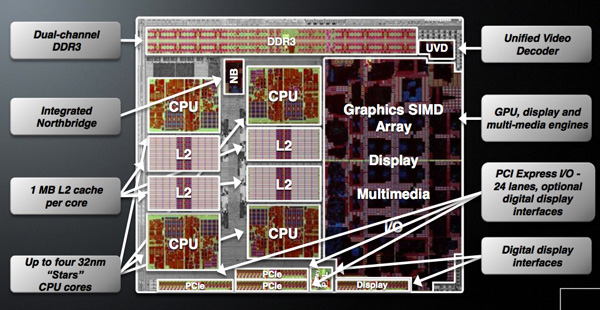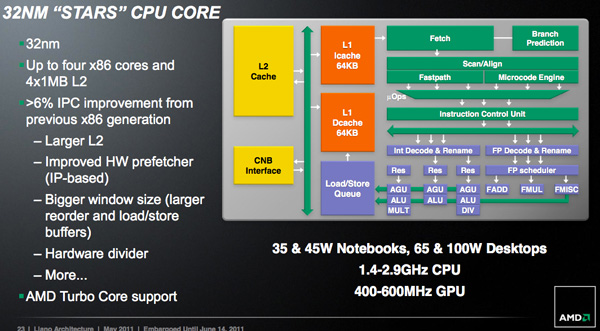The AMD Llano Notebook Review: Competing in the Mobile Market
by Jarred Walton & Anand Lal Shimpi on June 14, 2011 12:01 AM ESTThe Llano A-Series APU
Although Llano is targeted solely at the mainstream, it is home to a number of firsts for AMD. This is AMD's first chip built on a 32nm SOI process at GlobalFoundries, it is AMD's first microprocessor to feature more than a billion transistors, and as you'll soon see it's the first platform with integrated graphics that's actually worth a damn.
AMD is building two distinct versions of Llano, although only one will be available at launch. There's the quad-core, or big Llano, with four 32nm CPU cores and a 400 core GPU. This chip weighs in at 1.45 billion transistors, nearly 50% more than Sandy Bridge. Around half of the chip is dedicated to the GPU however, so those are tightly packed transistors resulting in a die size that's only 5% larger than Sandy Bridge.
| CPU Specification Comparison | ||||||||
| CPU | Manufacturing Process | Cores | Transistor Count | Die Size | ||||
| AMD Llano 4C | 32nm | 4 | 1.45B | 228mm2 | ||||
| AMD Llano 2C | 32nm | 2 | 758M | ? | ||||
| AMD Thuban 6C | 45nm | 6 | 904M | 346mm2 | ||||
| AMD Deneb 4C | 45nm | 4 | 758M | 258mm2 | ||||
| Intel Gulftown 6C | 32nm | 6 | 1.17B | 240mm2 | ||||
| Intel Nehalem/Bloomfield 4C | 45nm | 4 | 731M | 263mm2 | ||||
| Intel Sandy Bridge 4C | 32nm | 4 | 995M | 216mm2 | ||||
| Intel Lynnfield 4C | 45nm | 4 | 774M | 296mm2 | ||||
| Intel Clarkdale 2C | 32nm | 2 | 384M | 81mm2 | ||||
| Intel Sandy Bridge 2C (GT1) | 32nm | 2 | 504M | 131mm2 | ||||
| Intel Sandy Bridge 2C (GT2) | 32nm | 2 | 624M | 149mm2 | ||||
Given the transistor count, big Llano has a deceptively small amount of cache for the CPU cores. There is no large catch-all L3 and definitely no shared SRAM between the CPU and GPU, just a 1MB private L2 cache per core. That's more L2 cache than either the 45nm quad-core Athlon II or Phenom II parts.

Intel's Sandy Bridge die is only ~20% GPU
The little Llano is a 758 million transistor dual-core version with only 240 GPU cores. Cache sizes are unchanged; little Llano is just a smaller version for lower price points. Initially both quad- and dual-core parts will be serviced by the same 1.45B transistor die. Defective chips will have unused cores fused off and will be sold as dual-core parts. This isn't anything unusual, AMD, Intel and NVIDIA all use die harvesting as part of their overall silicon strategy. The key here is that in the coming months AMD will eventually introduce a dedicated little Llano die to avoid wasting fully functional big Llano parts on the dual-core market. This distinction is important as it indicates that AMD isn't relying on die harvesting in the long run but rather has a targeted strategy for separate market segments.
Architecturally AMD has made some minor updates to each Llano core. AMD is promising more than a 6% increase in instructions executed per clock (IPC) for the Llano cores vs. their 45nm Athlon II/Phenom II predecessors. The increase in IPC is due to the larger L2 cache, larger reorder and load/store buffers, new divide hardware, and improved hardware prefetchers.
On average I measured around a 3% performance improvement at the same clock speed as AMD's 45nm parts. Peak performance improved up to 14% however most of the gains were down in the 3—5% range. This is arguably the biggest problem that faces Llano. AMD's Phenom architecture debuted in 2007 and was updated in 2009. Llanos cores have been sitting around for the past 3-4 years with only a mild update while Intel has been through two tocks in the same timeframe. A ~6% increase in IPC isn't anywhere near close enough to bridge the gap left by Nehalem and Sandy Bridge.
Note that this comparison is without AMD's Turbo Core enabled, but more on that later.












177 Comments
View All Comments
Shadowmaster625 - Monday, June 20, 2011 - link
Can you try setting the affinity manually so that it has to use only one core? I notice that even though I'm running only one thread, that thread will jump around to all my available cores, making them all look like they are running at 25%. Maybe by the time AMD's turbo kicks in, the thread is already moved to another core.GullLars - Tuesday, June 14, 2011 - link
Looking forward to the re-test with an SSD.IMHO all machines over $600 meant for general purpose use in 2011 should include at least a 32GB SSD of Indilinx Barefoot performance or better.
My laptop from 2007 with 2,2GHz C2D and a 32GB Vertex (retrofitted in 2009) still wipes the floor with new $800+ laptops with HDD-only for general use.
JarredWalton - Tuesday, June 14, 2011 - link
Having played with a bunch of laptops using 64GB SSDs, they all feel snappier, though of course it doesn't help with gaming frame rates or CPU computations. Still, I have to say that 64GB isn't big enough for me. If you can get a 32GB mSATA SSD and some sort of SSD caching, and then have a main 500GB HDD, that would be the sweet spot. If you're going SSD-only, I need at least 120GB, and for anything that can run games I'd want 240GB. (By the time I install most of the games I'm currently interested in playing on a regular basis, I easily fill up a 120GB drive.)Anyway, I'm swapping in the SSD now and will start testing during the week, with the follow-up article hopefully ready next week. I've got DC SNB, Arrandale, DC Phenom II, E-350, and now Llano for the article. Anything else you want to request before I call it quits? I've still got the XPS L502x and an AMD K625, but I figure the five laptops are a reasonable representation of what's currently out there. (Note that I have currently focused only on IGP equipped laptops.)
Boissez - Tuesday, June 14, 2011 - link
Results with/without DDR3 RAM would be interesting as it seems RAM speed is a bottleneck.Boissez - Tuesday, June 14, 2011 - link
dang... That should have been with/without DDR3 1600 Mhz RAMBrian23 - Tuesday, June 14, 2011 - link
Application compile benchmarks. ;-)Cloudie - Tuesday, June 14, 2011 - link
The battery life has exceeded my expectations although battery life is a low priority for me when buying a laptop. As long as it gets 4 hours or so at idle is fine by me.Both the GPU and CPU performance has disappointed me somewhat but on the plus side I was not aware until now that the APU being tested was a 35W version, I simply assumed it was the fastest 45W one. Hopefully the CPU perfomance will be just that little bit better on the 45W APUs. And OEMs better get out some decent compact systems with this in... I'd say 13-14" chassis will do me just fine.
just4U - Wednesday, June 15, 2011 - link
If they can get this priced out in a $600 laptop with all the bells and whistles... It will sell. Looking locally (and online) decent gaming laptops start out at about $800. Looking at the numbers it's more then acceptable I think. Profit has to be in there though for AMD.. If their not turning an acceptable profit on each chip then... it will be a wash.duploxxx - Wednesday, June 15, 2011 - link
Looking at the recent preview of anandtech on the desktop Liano part and the increased performance from DDR1333 to DDR 1866 i would like to see what it would bring on a Mobile platform. Afterall LIano mobile does support ddr 1600http://www.anandtech.com/show/4448/amd-llano-deskt...
Germanicus - Wednesday, June 15, 2011 - link
1600 MHz DDR3 - lets make this accurate, since Llano can utilize it.Thank you.